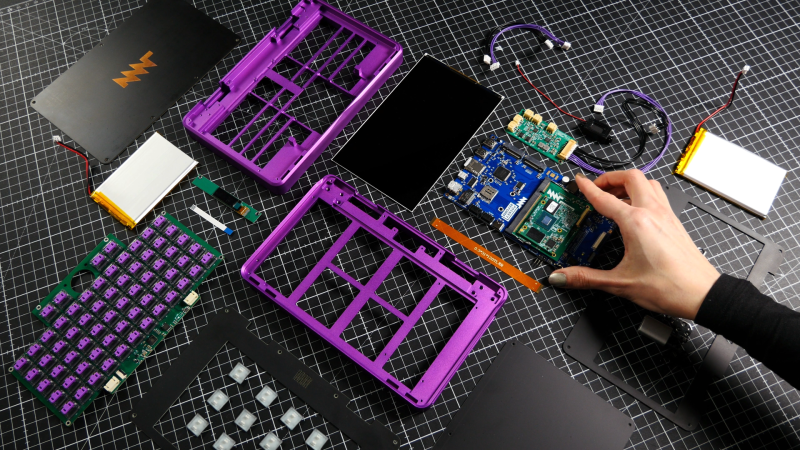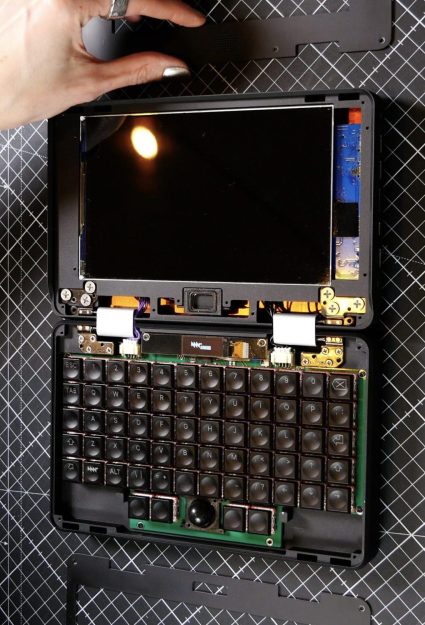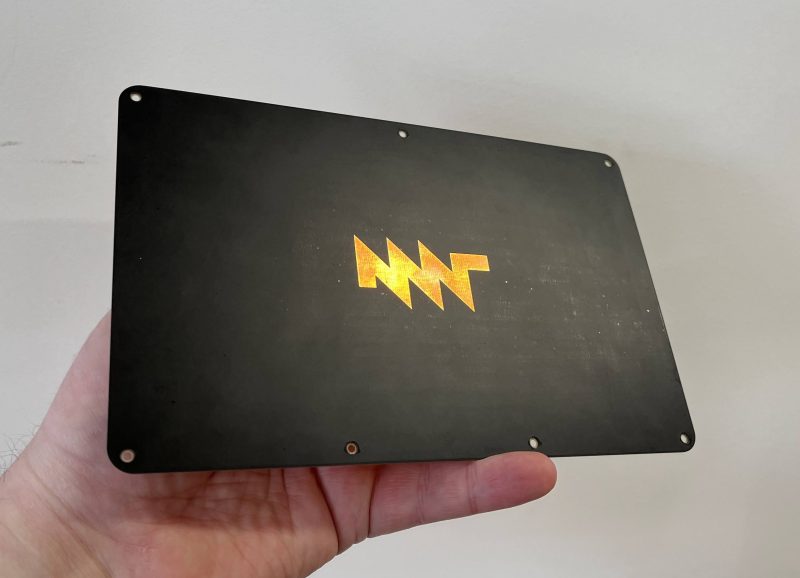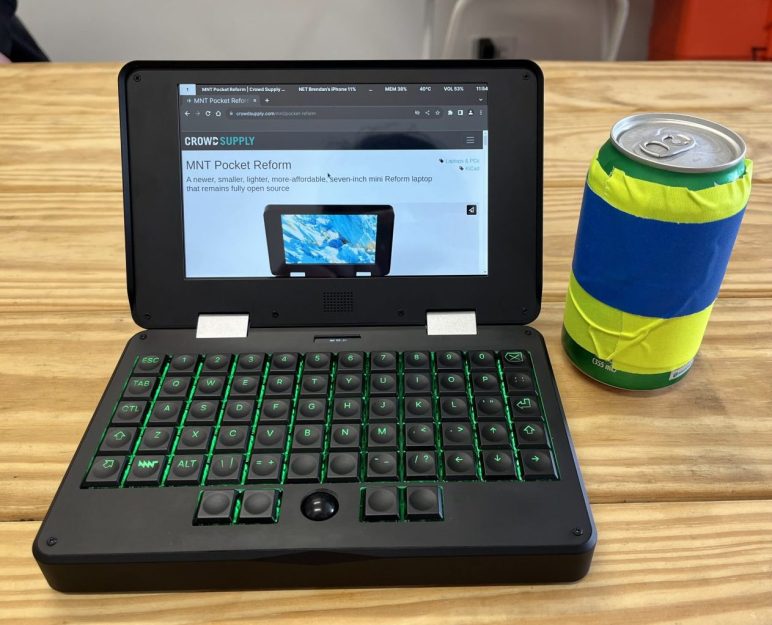
Last time Hackaday went hands on with a product from German company MNT, it was the Reform laptop; a full size computer with a full feature set and fully open source design. Now they’re back with the same value proposition and feature set crammed into a much more adorable (and colorful!) package with the MNT Pocket Reform. If you want the big Reform’s open source philosophy in a body fit for a coat pocket, this might be the computing device for you.
To refresh your memory, MNT is a company that specializes in open source hardware and the software to support it. They are probably best known for the Reform, their first laptop. Its marquis feature is a fully open design, from the mechanical components (designed with OSS tools) to the PCBAs (designed with KiCad) to the software (designed with, uh, software). When originally shipped that product packed a DIMM-style System On Module (SOM) with a default configuration containing a quad core NXP i.MX8M Quad and 4GB of RAM, as well as mini PCIe Card and M key m.2 2280 slots on the motherboard for storage and connectivity. That computer was designed to be easily serviceable and included a plethora of full sized ports along with easy to source cylindrical battery cells. The Pocket Reform takes the same intent and channels it into a much smaller package.
Speeds and Feeds

Looking at the Pocket Reform side by side with big Reform, the family resemblance is clear. From the smooth bead-blasted finish on the aluminum chassis to the chamfered edges to the squared off profile, you won’t mistake this for anything besides a Reform. And picking it up is no different. The Pocket Reform is so rigid and dense you almost believe someone forgot to machine out the center of this block of billet. The only blemishes are the obviously necessary IO ports on one edge, and slightly different texture on the top lid (more on that in a moment).
Despite its stature the Pocket Reform accepts the same processor SOMs as big Reform. By default it will ship with a newer, souped-up SOM from the same vendor, Boundary Devices. This one will include an I.MX8M Plus with 8 GB RAM and a 128GB EMMC, as well as a possible small overclock. However for the most part the alternative SOMs developed for big Reform will work just as well, such as the Pi 4 compute card adapter. The caveat is that they need to support the correct display interface (for example we were warned the substantially more powerful LS1028A module would need an adapter).

For ports, the Pocket sports a somewhat more limited but modern selection; two USB-C (one with Power Delivery to charge the Pocket), micro SD, ix Industrial Ethernet port (adaptable to RJ45), and micro HDMI. These are all exposed on the right edge of the display, while the left side has a blanking plate just waiting for an ambitious hacker to modify. Internally the mainboard has two m.2 slots; one 2280 with PCIe intended for NVMe storage and one 2242 with USB for connectivity, suggesting a cell modem or the like. Non-WWAN wireless connectivity is up to the SOM, with the default Boundary board including WiFi 802.11ac and Bluetooth 5.0. Notable for our post-COVID world is the addition of an onboard mono speaker and mic, two devices missing from the original Reform.
 Pop open the magnetically-latched display and fold the screen to a comfortable angle and you’ll discover the cornucopia of IO within. We know our readers are nothing if not input-enthusiasts, so rejoice in the knowledge that even in this reduced form factor low profile Kailh Choc switches carry the mechanical keyboard torch accompanied by a diminutive trackball. MNT says the entire Pocket was sized to match the smallest keyboard they could reasonably ask a user to type on and they got their millimeter’s worth. In our brief fingers-on with the RGB backlit keyboard it was as satisfying as you’d expect for the low profile mechanical Choc switches and seems like it would be a blast to tap away at once you were acclimated to the ortholinear design and compact layout. Though small, the trackball was no slouch either; letting us whip the cursor around with wild abandon as well as position precisely. The only confusion was from the fully remappable “clicking” button layout, but that is easily adjustable to match the user’s preference.
Pop open the magnetically-latched display and fold the screen to a comfortable angle and you’ll discover the cornucopia of IO within. We know our readers are nothing if not input-enthusiasts, so rejoice in the knowledge that even in this reduced form factor low profile Kailh Choc switches carry the mechanical keyboard torch accompanied by a diminutive trackball. MNT says the entire Pocket was sized to match the smallest keyboard they could reasonably ask a user to type on and they got their millimeter’s worth. In our brief fingers-on with the RGB backlit keyboard it was as satisfying as you’d expect for the low profile mechanical Choc switches and seems like it would be a blast to tap away at once you were acclimated to the ortholinear design and compact layout. Though small, the trackball was no slouch either; letting us whip the cursor around with wild abandon as well as position precisely. The only confusion was from the fully remappable “clicking” button layout, but that is easily adjustable to match the user’s preference.
A few final tidbits. The display is sharp at 1920×1200 on a miniscule 7” diagonal footprint, but depending on your eyes high density may not solve small size. Suffice to say that at 310 ppi you can choose freely between less bigger content and more microscopic letters, though if you choose bigger content there may be relatively little of it. And yes Thinkpad fans, the hinges (taken from big Reform) allow the screen to fold open to a fully flat 180*.
The chassis divides batteries and input devices into the bottom half, with display, mainboard, and ports into the top. In our uncalibrated hands it felt well balanced and not likely to tip when used on a flat surface. It’s small enough that it could conceivably be used for handheld thumb typing or gaming, though that would probably require a customized keyboard and input device. Finally the topmost surface on the lid is actually a single blank PCB (note the pleasing raw copper finish on the MNT logo) for easy design customizability or expansion.
Why Build It Now?

With the original MNT Reform shipping recently in 2021 and Pocket Reform slated to reuse the core components, we wondered why the time was right to ship this product now. One of the main drivers was accessibility without compromising feature completeness. We will dig into Pocket Reform pricing in more detail but comparable hardware configurations cost about $500 less in Pocket form than in big Reform size. Those savings can be attributed to a mixture of things well summarized as “fewer components and smaller size”. Smaller size means less material used, one big mainboard with everything on it means fewer cable harnesses, and on and on. But the broader point still stands that for a product like this the market isn’t any more crowded now than it was a few years ago.
Like the original MNT Reform, this is a polarizing device. Want something thin and light? That’s not the Pocket Reform (thought it might fit in a generous cargo pants pocket). Care about a screen with the deepest blacks and highest refresh rate? Also not Pocket Reform. Gaming on the go? Retro emulators are probably a great experience, but you won’t be playing AAA shooters. And at a starting price of $899 it is out of impulse buy territory for most people. But not every product needs to appeal to the middle of the bell curve, modern manufacturing accessibility lets companies successfully target the ends of the spectrum to find niche customers who are underserved by other options. MNT is betting that there are enough people looking for a secondary device for distraction free writing on the go or the hard core couch surfing who are drawn to something either more open or just more interesting and are willing to take the leap.
Users and the Future

As before and above all else, what makes the MNT Reform family stand out to us is openness. If you want a fully libre device which is also an off the shelf commercial product, which you can buy as a fully functional, fully assembled product and use right out of the box, the Reforms are pretty much it. There are other laptops that prioritize repairability, but they don’t provide sources for any of their components and you can’t replicate or modify either their hardware or closed source software yourself. There are single board computers and keyboard cases that run free or mostly free software, but their hardware sources aren’t available either.
Looking at the trajectory of the Reform products so far, we can extrapolate out to what might come next. If the Pocket Reform mainboard and SOMs are compatible, and the input devices are compatible, you can remix them bigger just as easily as smaller. It sounds like MNT is aware that there are untapped users who are interested in large and thin instead of the Pocket’s small but thick. Maybe these users are philosophically aligned with the approach but prioritize portability over the ability to easily expand the device with more modules. If you take the big Reform chassis but swap the trackball and cylindrical battery cells to remove unused space, then drop in a Pocket Reform mainboard (which again, takes the same SOMs) that leaves you with a pretty compelling package. We’re excited to see what MNT has in store for us next.
A Miniature MNT For Every Pocket
Source: Manila Flash Report
0 Comments